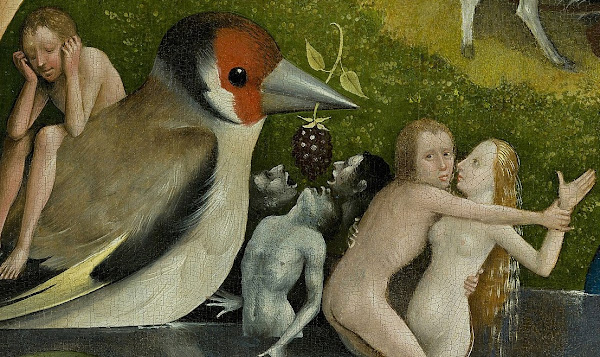Far from the beach, but still surrounded by treasure of all kinds just ready to be found, looked at, gloated over, gleaned and swiped or simply created! Here are my latest finds....
Saturday, December 30, 2023
All Things Bright and Beautiful... The Goldfinch.
I recently came across two Renaissance altarpiece paintings representing the Virgin and the Child, the one above by a Florentine master in the early 14th century, and the one below by a Mantuan master in the 16th century. Despite the two centuries that separate these works, and the differences in painterly approach and technique that are apparent, the one key feature that is common to both is the enigmatic presence of a goldfinch. Although I had seen these beautiful birds as details or conversely the main subject of a piece of art, I had never associated them with any specific religious significance.
Of course, I am referring to the rather menacing giant finch in Hieronymus Bosch's Garden of Earthly Delights (circa 1400), with its glinting eye and pointed beak near the vulnerable, nude forms of carnal pleasure-seekers, followed by The Goldfinch of 1654 by another Dutch painter, Carel Fabritius (image: Wikimedia Commons). Both birds are striking with their boldly-coloured plumage and are intriguing too as they lead us to puzzle over their significance or perhaps lack of one... Was there a shared meaning at work, over the centuries, in these pieces and furthermore how does this tie in with the altarpieces?
Apparently, the goldfinch is not cited in the Bible, and yet this particular bird is repeatedly portrayed in Renaissance religious paintings, for the large part of Italian origin or influence. In most cases, the goldfinch is held in the hand of the child Jesus, or is held out to Him by his mother, Mary. In this manner, the bird thus symbolizes Christ's Passion (derived from the Latin passus "to suffer"), since like the red-breasted robin, the goldfinch is stained by the blood of the Saviour with its distinctive scarlet facial markings. These wounds were earned as the valiant songbirds attempted to pluck away the spines from the crown of thorns. Along with suffering and death, there is also the image of ressurrection, with the finch's golden flight feathers, offset by dramatic black, as symbols of hope and salvation. Leonardo da Vinci, Raphael, Zurbaran and Tiepolo all included the finch in their Madonna and Child works; below is da Vinci's Madonna Litta (circa 1490).
The goldfinch was also considered to be a protection against illness, acting as a caladrius; a bird with restorative and healing powers, should the sick person stare into its eyes. Even in Ancient Greece, the yellow eyes of a bird were held to possess curative qualities, especially in the case of jaundice. Since the Black Death had decimated a large proportion of the inhabitants across Europe in the mid 14th century, individuals were prepared to cling to any remedy, however implausible (or unsavioury)! Leonardi de Vinci observed "The gold-finch is a bird of which it is related that, when it is carried into the presence of a sick person, if the sick man is going to die, the bird turns away its head and never looks at him; but if the sick man is to be saved the bird never loses sight of him but is the cause of curing him of all his sickness". Thistles - the vegetation of predilection for the goldfinch - were believed to combat the plague and were largely considered to be sacred plants.
Apart from these presumed attributes, the goldfinch has always been valued as household pet - not merely for its appearance and captivating bird song, but also its ability to perform tricks... such as filling up a thimble of water. As such, the goldfinch was kept in a cage or attached by a string, as was the case of Carel Fabritius' fine specimen, and as an imprisioned being, deprived of free flight, was the subject of many poems, perhaps the most famous of which is The Caged Goldfinch by Thomas Hardy.
Finally, although I live in a rather ugly street that accommodates a tramline, I am graced with the presence of many goldfinches each spring, all gathering in the scrubby trees that punctuate the pavement below my flat. The first time I made out the birdsong above the constant noise of road traffic and trams, I wondered which hardy little creature could sing like that, until I saw the elusive goldfinches, hidden away in the branches. It just goes to show how the beauty and enchantment of Nature can be found anywhere...
Subscribe to:
Post Comments (Atom)





No comments:
Post a Comment
Leave a message - please share your ideas!